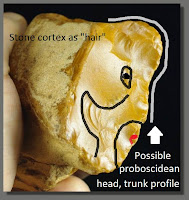Acheulean jasper scraper from the Grand-Pressigny, central France
Collection of Ken Johnston, this perspective interpreted as a human face in right profile view
Typology : Pointed Side Scraper.
Material : Yellow Jasper.
Cutting : This implement was cut in a Jasper pebble. A few flakes were cut to create the pointed sub-triangular shape. The three points and the edges were finely retouched. Both faces and one side were left mostly cortical to ensure a strong and safe grip.
Dating, hominid : This implement belongs to the Acheulean Culture (Lower Paleolithic period, circa 300 000 to 650 000 years ago), and was conceived by Homo HEIDELBERGENSIS ( European Erectus ).
Origin : Found in the area of the Grand-Pressigny, in the center of the France; discovered in the Creuse's ancient riverbed.
Sizes : 3 7/8 inches X 3 7/8 inches or 9.5 cm X 9.5 cm
Weight : 280 g
Condition : Intact, no modern damage
Click photos to expand and compare
A somewhat similar facial profile identified by Dennis Boggs, Boardman, Oregon, on this beautiful translucent crystal laden flake (a "lithophane," Johnston) where the crystal area (cortex) may be seen to serve as "hair" in the anthropomorphic facial profile. The artifact depicts a left facial profile which has been inverted in this photo to allow comparison against the French example from the same perspective
This second right facial profile on the same artifact seems more zoomorphic than anthropomorphic. It may an intentional representation of an animal such as a baboon
Acheulean jasper scraper from the Grand-Pressigny, central France
Collection of Ken Johnston
The above perspective shows how elusive possible iconography is to collectors and archaeologists working in the field. The above photo, showing the artifact as perhaps taken at usual "macro level" of archaeological interpretation, may be seen as a relatively insignificant worked block of flint. Only upon very close examination of the retouch work can the details of possible zooanthropomorphic forms be revealed. With this more "micro" level of examination of artifacts in existing collections and at sites yet to be discovered, it will be seen that Boucher de Perthes himself was correct is positing the existence of art right with the tools of his "antedelluvian man."
-kbj




.jpg)



No comments:
Post a Comment